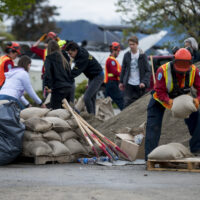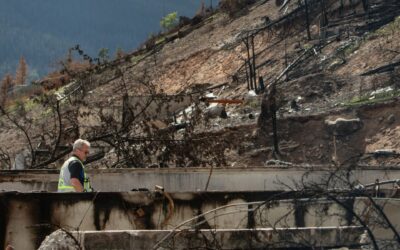Floods, fires, and heat domes—after a summer of record-breaking heat and escalating climate disasters, all eyes are on Glasgow, where the nations of the world will gather in the coming weeks to clarify and strengthen Paris Agreement commitments in order to avert catastrophic warming.
The COVID-19 pandemic delayed this 26th COP (short for “Conference of Parties”) by a year. This means that stakes are even higher for making progress on crucial issues that—let’s face it—the world has anything but the luxury of time to resolve.
COP26 is also especially important for Canada. It will be a first major appearance on the world stage for a federal government that has a renewed mandate, including on climate action, and new climate commitments in hand. And Canada has been charged with co-leading crucial efforts to boost climate finance for developing countries (see #2 below).
So what would a much-needed win at COP26 look like? Here are five markers of success at the upcoming United Nations Glasgow climate meeting, which runs from October 31 to November 12, 2021.
1. Raising ambition to reduce emissions
Under the Paris Agreement, countries agreed to submit a climate plan (a “nationally determined contribution” or NDC in UN-speak) every five years, representing each nation’s contribution to meeting the global goals. Countries also agreed that each NDC must be more ambitious than the last. This is the first COP post-Paris where countries will show how seriously they’re delivering on that commitment to ambition.
Latest assessments of where we’re headed are sobering. Collectively, countries’ stated targets get us to a global temperature rise of around 2.7 degrees Celsius—nearly twice the 1.5 degrees of warming scientists see as an existential red line. Meanwhile, the latest IPCC report is a stark reminder of just how bad the climate change we’re already seeing could become. What’s more, NDCs are shorter-term commitments to 2025 or 2030. In order to keep the long-term prize within reach, it will be crucial for countries to have plans for reaching deeper reductions by mid century.
Markers of success:
- Updated NDCs with greater ambition, especially from countries like China and India that have yet to submit their revised plans
- New long-term plans consistent with achieving net zero by 2050
Canada’s role:
- Canada updated its NDC earlier this year, including a more ambitious 2030 target of 40-45 percent reductions in emissions from 2005 levels: the federal government is mandated by the new Net Zero Emissions Accountability Act to deliver the country’s first 2030 emissions reduction plan — to make those targets real — by the end of December. So Glasgow lands in the middle of a crucial few months for Canada’s climate ambition.
- Canada has committed to achieving net zero emissions by 2050, but needs to update its long-term strategy to reflect that commitment.
2. Mobilizing international finance for developing countries
Back in 2009, wealthy nations pledged to mobilize US$100 billion per year in finance for developing countries by 2020, partly to help with the costly work of reducing emissions and adapting to impacts and partly in recognition of their historical responsibility for climate change. Rich countries have yet to make good on this commitment and have extended the deadline to 2025. The impacts of this unmet promise are symbolic as well as material, eroding good faith and trust across all negotiations.
Markers of success:
- Increased pledges by developed countries for international climate finance.
Canada’s role:
- Canada is co-leading, with the United Kingdom, an effort to fulfill the US$100 billion per year commitment.
- Canada recently doubled its own commitment to $5.3 billion over five years, although independent analysis shows this is just a quarter of its fair share.
3. Elevating adaptation in the global agenda
Success in tackling the climate crisis is often measured solely in terms of the emissions we reduce, and while emission reductions are crucial, they aren’t the whole story. Countries are facing the impacts of a changing climate now, and worsening impacts are baked into the climate system, even if we halted all emissions today. While developing countries are most vulnerable, our analysis shows that even the wealthy nation of Canada faces serious challenges in preparing for and minimizing increased losses from a warming climate. Canada also benefits from international efforts to enhance resilience, by reducing global economic instability and supply chain disruptions. Even as countries increase their ambitions on reducing the burning of fossil fuels, they need to be building and preparing for the warmer climate we’re already starting to experience.
Markers of success:
- Progress on developing metrics to track progress towards the global adaptation goal of “enhancing adaptive capacity, strengthening resilience, and reducing vulnerability to climate change.” (This is especially important with a formal global stock-taking process beginning this year.)
- Global finance commitments for adaptation. (Most funding currently goes to reducing emissions.)
- Stronger focus on adaptation (including submission of adaptation plans) in country NDCs.
Canada’s role:
- Canada, which is warming twice as fast as the global average, was a convening member of a global initiative aiming to raise the political profile of adaptation.
- Canada has committed to developing a National Adaptation Strategy, though Canada’s NDC provides little detail on adaptation plans.
4. Agreeing to rules for carbon markets
The set of rules for international carbon markets has been a sticky negotiation topic since Paris. In fact, it’s one of the last issues to be resolved to enable the Paris Agreement to be fully implemented.
The unresolved details of Article 6 of the agreement are technical, to say the least. They include the need to establish accounting rules for emissions reductions transferred between countries, as well as a mechanism to carry over unused credits generated under the Kyoto Protocol. Yet, a good resolution on Article 6 really matters. As more countries voluntarily engage in international emissions trading and offsetting, robust rules will ensure these activities result in tangible and lasting emissions reductions. Without those clear and consistent rules, the ability of international carbon markets to actually reduce emissions will be severely compromised.
Markers of success:
- Resolution on the wonky issues of “double counting,” carry-over of credits from the Clean Development Mechanism (CDM) of the Kyoto Protocol, and how a “transaction tax” on the generation of credits is used.
Canada’s role:
- Canada has stepped back from a stated intention to use future Article 6 rules to gain credit for displacing fossil fuels in other countries with Canadian liquefied natural gas (LNG) exports. (We said at the time that Canada’s stance was off the mark, so its reversal is welcome).
- Canada has stressed the need to avoid double counting in international markets
5. Aligning private finance with climate goals
The transition to a global low-carbon economy requires aligning financial flows with climate targets. Given the huge investments needed for this transition, public finance alone, though important, won’t suffice. Private capital will be needed. Clear, internationally harmonized rules around climate-related financial disclosures and the labelling of financial products are critical to ensuring private capital flows in the right directions.
We are releasing a report on October 21 that assesses the risks and opportunities that Canada will face in the global low-carbon transition. It recommends that governments put in place policies, financial incentives, and disclosure rules to mobilize private investment for the economic transformation needed to secure Canada’s future prosperity.
Markers of success:
- Commitments for mandatory (rather than the current voluntary) risk reporting based on recommendations of the Task Force on Climate-Related Financial Disclosures (TCFD), a body that developed guidelines for companies to disclose their climate-related risk.
- Progress on globally consistent quantitative metrics to fairly compare the climate-related performance of companies.
Canada’s role:
- Climate-related disclosure is growing in Canada but remains voluntary and inconsistently applied.
- Canada has made a bid to host the global headquarters for the International Sustainability Standards Board, which could strengthen Canada’s influence in shaping globally consistent and comparable climate and ESG standards.
What happens in the negotiation halls of this COP may appear detached from the roll-up-your-sleeves hard work of tackling the climate crisis in the real world. But its outcomes will have concrete and wide-reaching implications for accelerating or hindering on-the-ground action.
The stakes are high in Glasgow, and success will be largely determined by progress on these five fronts. The world is watching.








